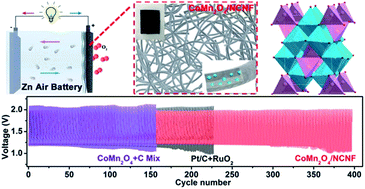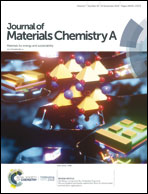Spinel oxide nanoparticles embedded in nitrogen-doped carbon nanofibers as a robust and self-standing bifunctional oxygen cathode for Zn–air batteries†‡
Abstract
Rechargeable metal–air batteries require nonprecious, efficient, and durable bifunctional electrodes for catalyzing the oxygen reduction/evolution reaction (ORR/OER). Here, we report a facile, scalable synthesis of a self-standing bifunctional electrode with CoMn2O4 (CMO) in situ embedded in nitrogen-doped carbon nanofibers (NCNFs) by electrospinning. Strong coupling between CMO and NCNFs facilitates the multiphase charge transport process. Meanwhile, the conductive carbonaceous network contributes to the overall stability by protecting CMO from corrosion and aggregation. As a result, the nanocomposite exhibits remarkable Pt-like ORR activity (onset/half-wave potential of 1.05/0.83 V) and high OER activity (overpotential of 340 mV at 10 mA cm−2). The rechargeable Zn–air battery assembled with CMO/NCNF delivers a peak power density of 224 mW cm−2 and a low charge–discharge voltage gap of 0.85 V even after 350 cycles at 10 mA cm−2. Furthermore, the assembled bendable solid-state Zn–air battery shows rechargeability, suggesting the promising potential of spinel/carbon hybrids in flexible devices.



 Please wait while we load your content...
Please wait while we load your content...